This is everything you need to know to bake the ultimate rich and creamy New York-style cheesecake. The recipe includes a classic shortbread crust with the option for a graham cracker crust if that's your preference.
"This is hands down the perfect cheesecake. Great texture and flavor, is not overly sweet, and is something I always get requests for. Another winner!" - Judy
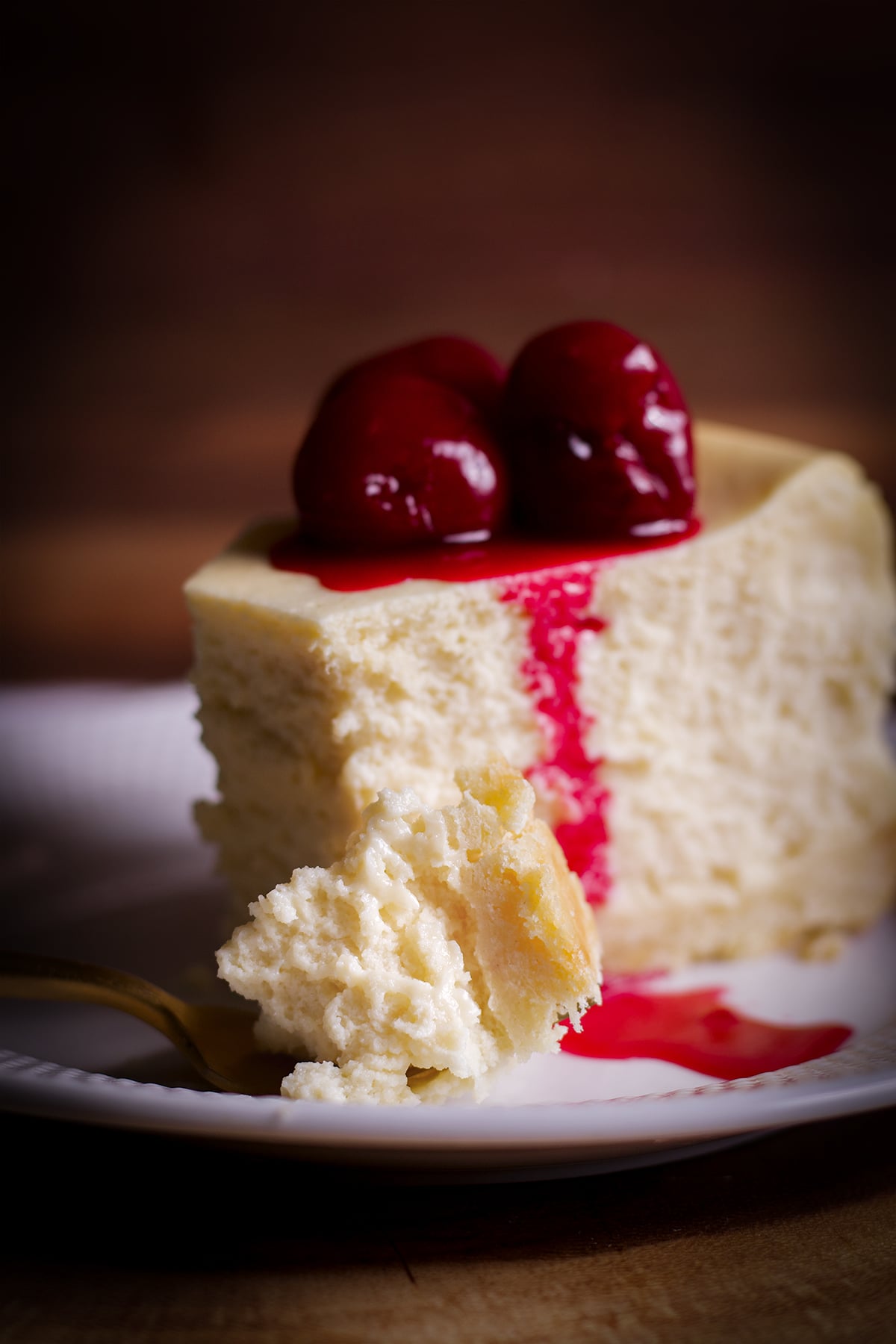

+ Subscribe to my newsletter for new and exclusive recipes in your in-box every month! As a full time traveler, living, working, cooking, and baking from a 5th wheel RV, it's also where I share our experiences of life on the road.
"Best cheesecake hands down. Followed this recipe to a tee. It turned out wonderfully and was seriously the best-tasting cheesecake anyone had ever tasted.” - Jennifer
This New York Cheesecake recipe includes everything I know about making it, storing it, freezing it, serving it, and even transporting and decorating it for a special occasion.
The really good news here is that making the kind of rich and creamy New York Cheesecake that everyone will be talking about for years is actually quite simple.
- This base cheesecake recipe can be used to create any kind of flavored cheesecake you desire
- The recipe includes a classic shortbread crust without graham crackers
- BUT, for all you graham cracker lovers, I've also included instructions for how to make a graham cracker crust instead
I've made this cheesecake countless times over the years, including for a few weddings. One bride told me recently that even though she's been married for over 12 years, people still bring up her wedding cake as the best cheesecake they've ever eaten.
I cannot think of a better compliment for a cheesecake recipe than that.
Before we get started on how to make a New York Cheesecake, I wanted to mention a couple of other recipes. These cheesecake bites are perfect for those times when you are craving cheesecake but don't need an entire cake. And if you ever want to bake a truly unusual and colorful cheesecake, try this delicious and bright purple ube cheesecake.
Jump to:
- What is New York-Style Cheesecake?
- Base Cheesecake Recipe Ingredients
- Classic Shortbread Crust Ingredients
- Step-by-Step Photos and Instructions
- Do You Have to Bake Cheesecake in a Water Bath?
- How to Bake a Cheesecake Wedding Cake
- Storage and Freezing Instructions
- Cheesecake Topping Ideas
- FAQs
- 📖 Recipe
- 💬 Comments
What is New York-Style Cheesecake?
New York-style cheesecake is tall, dense, and incredibly rich and creamy. The pinnacle of indulgence.
The center of a New York Cheesecake should be silky smooth and soft - somewhat like the consistency of really good pastry cream. Then, moving out to the edges, the cake should gradually get firmer, changing ever so slightly from soft and creamy to drier and cake-like.
The flavor of a classic New York Cheesecake is pure and simple. Elegant. The cake should taste rich, slightly tangy, not cloyingly sweet, with just a hint of vanilla or a touch of citrus.
New York Cheesecake should NOT be thin, airy, gummy, chewy, dry, or heavy.
Critics of New York Cheesecake (yes, they exist) claim that this style of cheesecake is too dense. On this point, I want to offer what I think is an important distinction: New York Cheesecake should be dense but not heavy.
Let me clarify - a dense, ultra rich texture is the entire point of a New York Cheesecake. If you're looking for a light-as-air kind of dessert, you're not going to find it in a New York-style cheesecake. But, dense and heavy are not the same thing.
The best analogy I can think of is the difference between a really good chocolate truffle and chocolate fudge. Both are rich and dense. But the truffle has a lightness to it, while the fudge feels heavy. Not a perfect comparison, but one that hopefully communicates the distinction I'd like to make.
In this recipe, the texture is dense but not heavy. It's rich and creamy in a way that melts on your tongue rather than something you have to work to chew your way through.
Base Cheesecake Recipe Ingredients
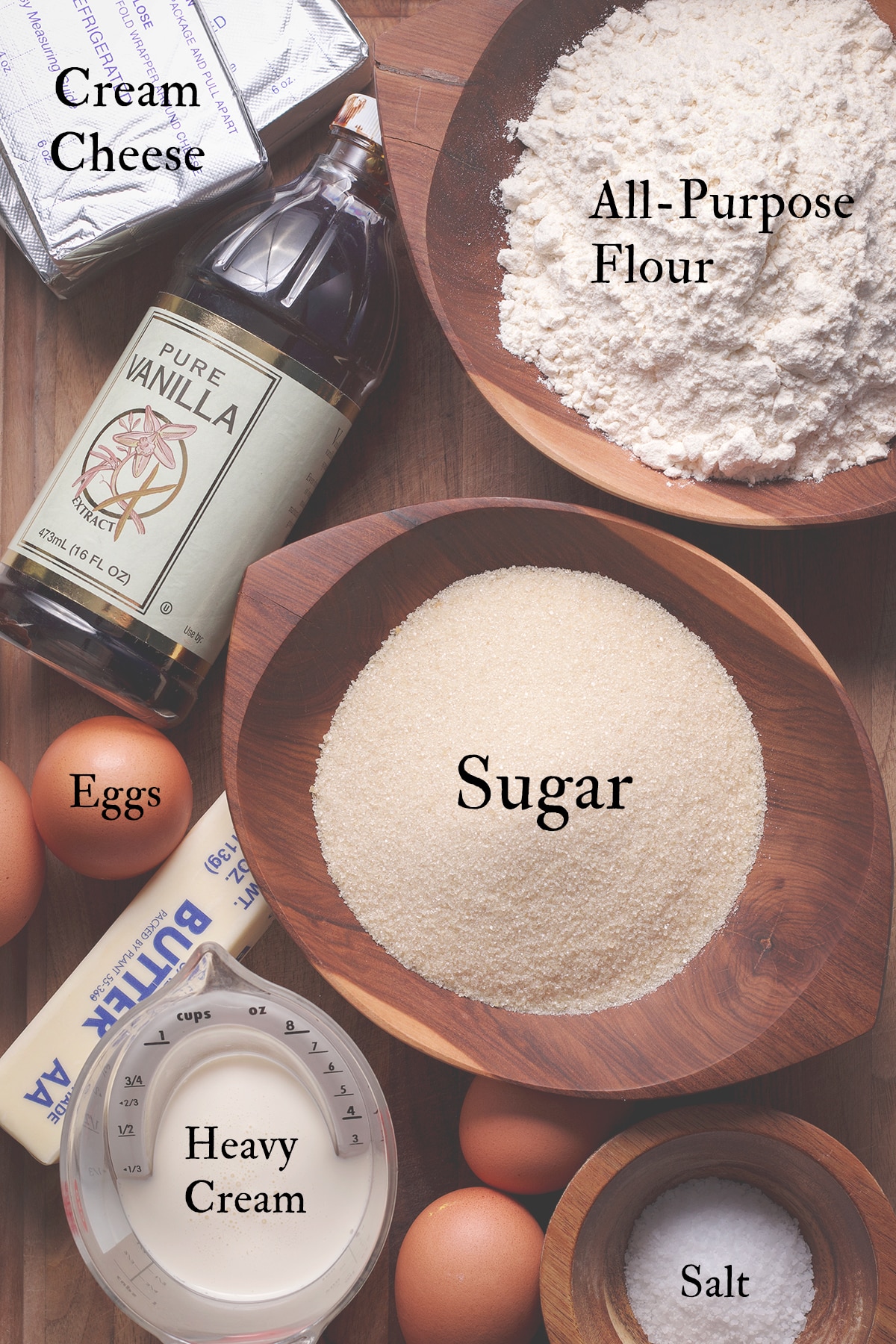
- Cream Cheese, obvi. This is not a time to skimp. Use high-quality full-fat cream cheese in this cheesecake.
- Granulated sugar. The overarching quality of a really good New York cheesecake is rich and creamy, not cloying. As such, this recipe includes enough sugar to make the batter sweet, but not overly so.
- All-purpose flour. Including a very small amount of starch creates a cohesive batter that bakes up into cheesecake that's easy to slice and has rich, velvety mouthfeel.
- Salt. A little bit of salt makes everything better, even cheesecake.
- Whole eggs and a few extra egg yolks. Eggs give cheesecake structure and richness and are essential to achieving a thick, stable, "set" consistency. But it's the egg yolks that give cheesecake a smooth, rich texture. To create an ultra creamy consistency, this recipe uses just enough whole eggs for structure, and a couple of extra yolks for extra richness.
- Heavy Cream. Most New York Cheesecake recipes call for sour cream, but I prefer heavy cream. Cream cheese already has a mildly tangy flavor and this recipe includes a whopping 32 ounces of cream cheese. Adding more tang in the form of sour cream interferes with the rich, elegantly simple flavor that's essential to an exceptionally delicious slice of cheesecake. Another bonus: Heavy cream also has a higher fat content than sour cream, further contributing to this cake's silky, ultra creamy texture.
- Vanilla. Use pure vanilla extract, not the imitation stuff. Alternatively, you can scrape the inside of a vanilla bean into the batter for an even more intense vanilla flavor.
Classic Shortbread Crust Ingredients
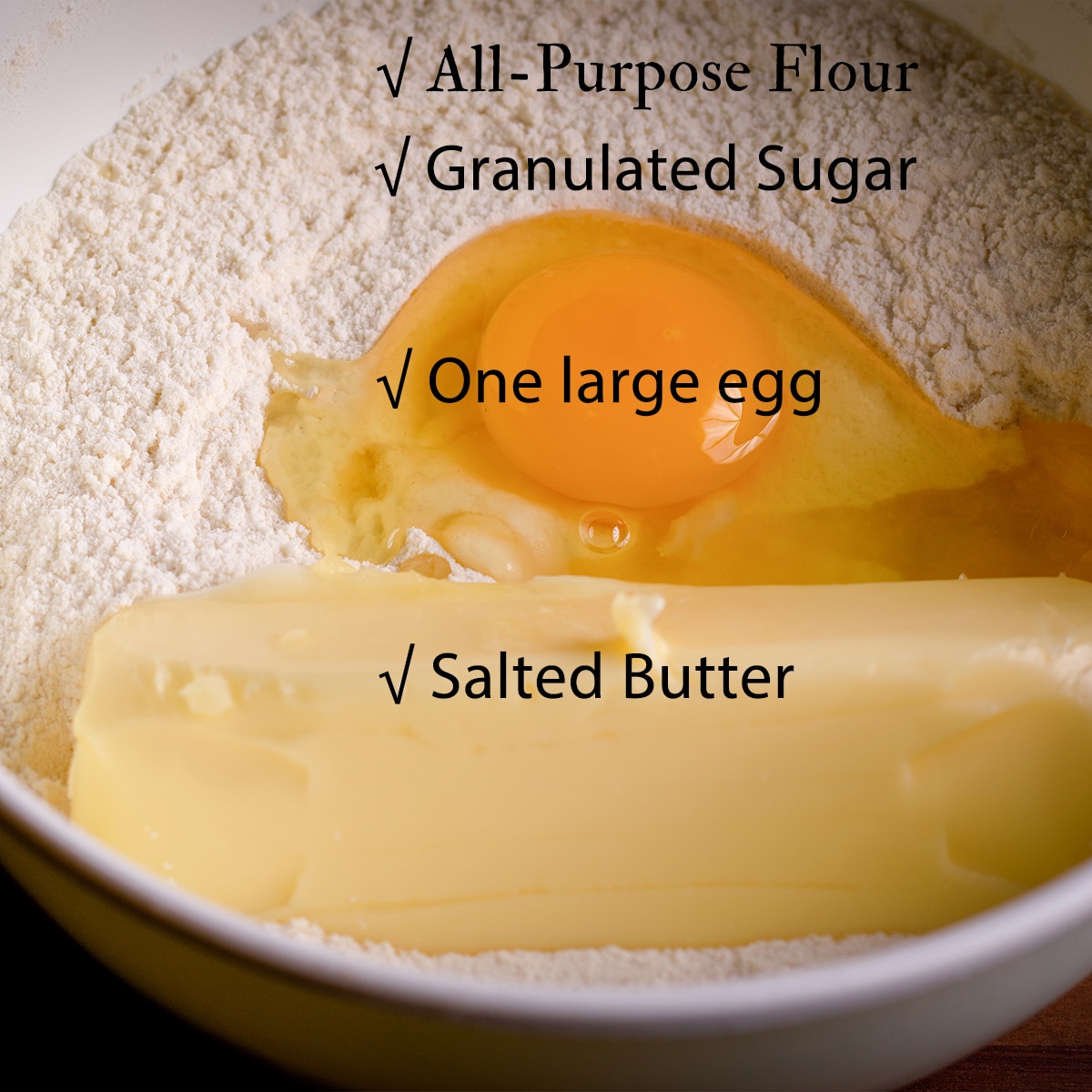
Although the vast majority of cheesecake recipes call for a graham cracker crust, "traditional" New York Cheesecake has a buttery, shortbread crust.
The crust is a simple mixture of 4 ingredients:
- All-purpose flour
- Granulated sugar
- One large egg
- Butter. I prefer to use salted butter, but if you're sensitive to salt, use unsalted.
This recipe makes a mild-flavored shortbread crust that's only very slightly sweet because its purpose is to showcase the star of the show - the cheesecake. The crust isn't trying to compete with the cheesecake. It's just there to support it.
Personally, I prefer this traditional shortbread crust to the sweeter, stronger flavors of a graham cracker crust. But, honestly, I'm not much of a traditionalist in anything. Eat what you like, I say.
If you're a graham cracker lover, you'll find instructions in the notes section of the recipe card for how to make a New York Cheesecake with a graham cracker crust.
Step-by-Step Photos and Instructions
New York-style cheesecake might be one of the most impressive and indulgent desserts to serve, but it's one of the easiest desserts to make. Here's how:
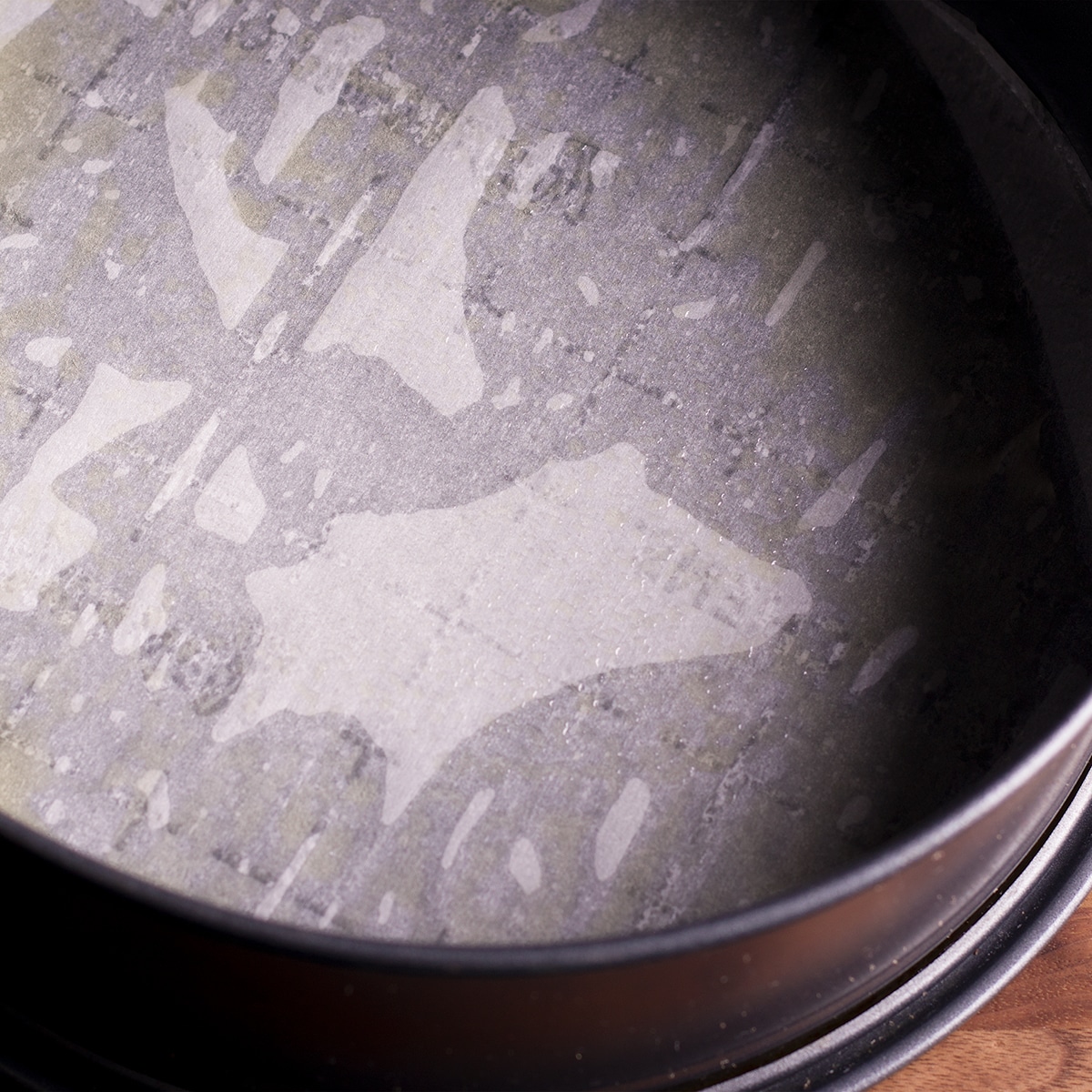
Before you get started making the shortbread crust, take a moment to prepare the pan so the cheesecake will not stick. Spray the inside of a springform pan with non-stick baking spray. Cut out a parchment round to fit the bottom of the pan and press it into the pan. Then, lightly spray the parchment with a bit of non-stick baking spray.
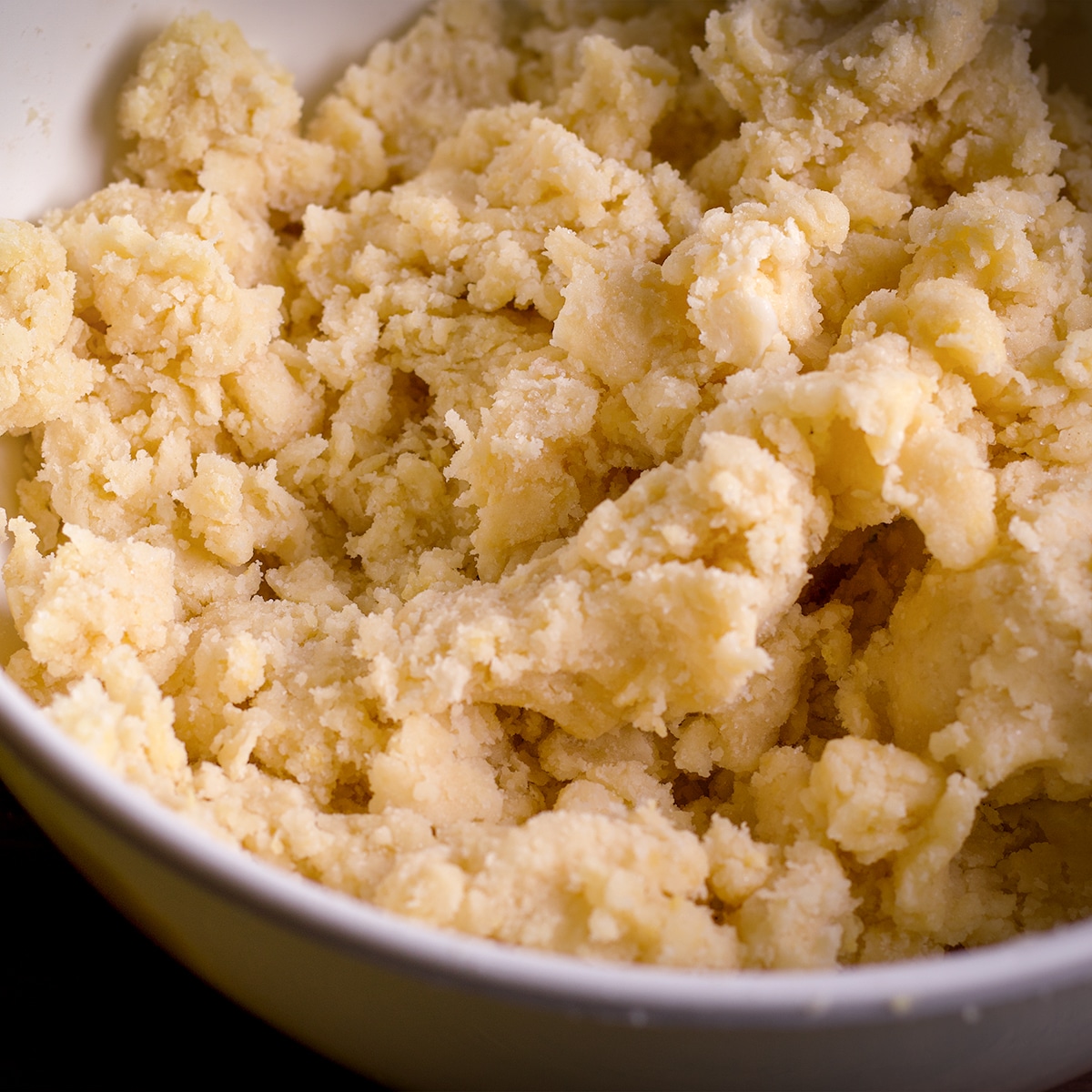
To make the shortbread crust, dump all the ingredients into a bowl and mix until they are moistened and form a dough.
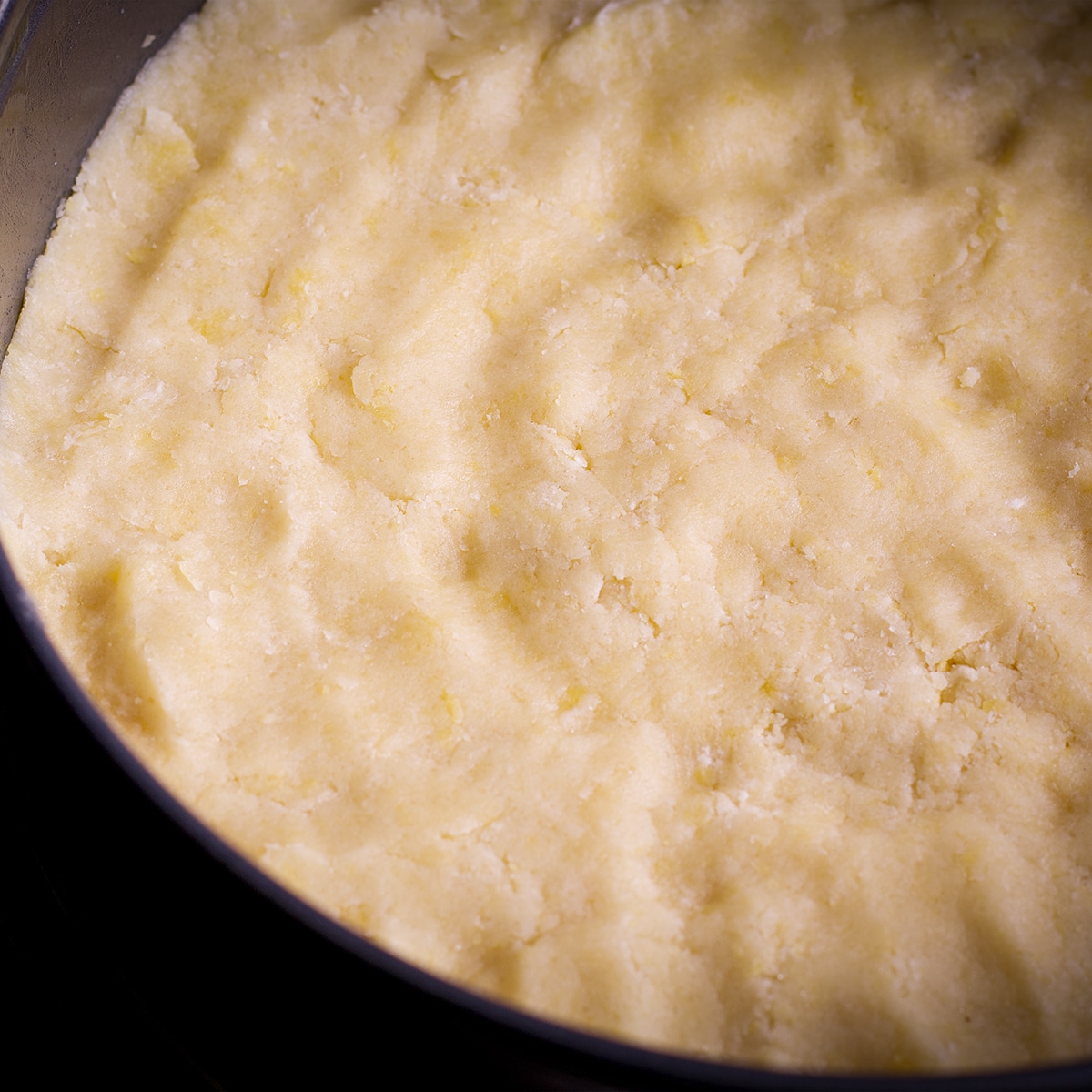
Press the dough into a springform pan that's been lined with parchment paper and sprayed with non-stick baking spray. The dough should cover the bottom of the pan and rise about a half-inch up the side of the pan.
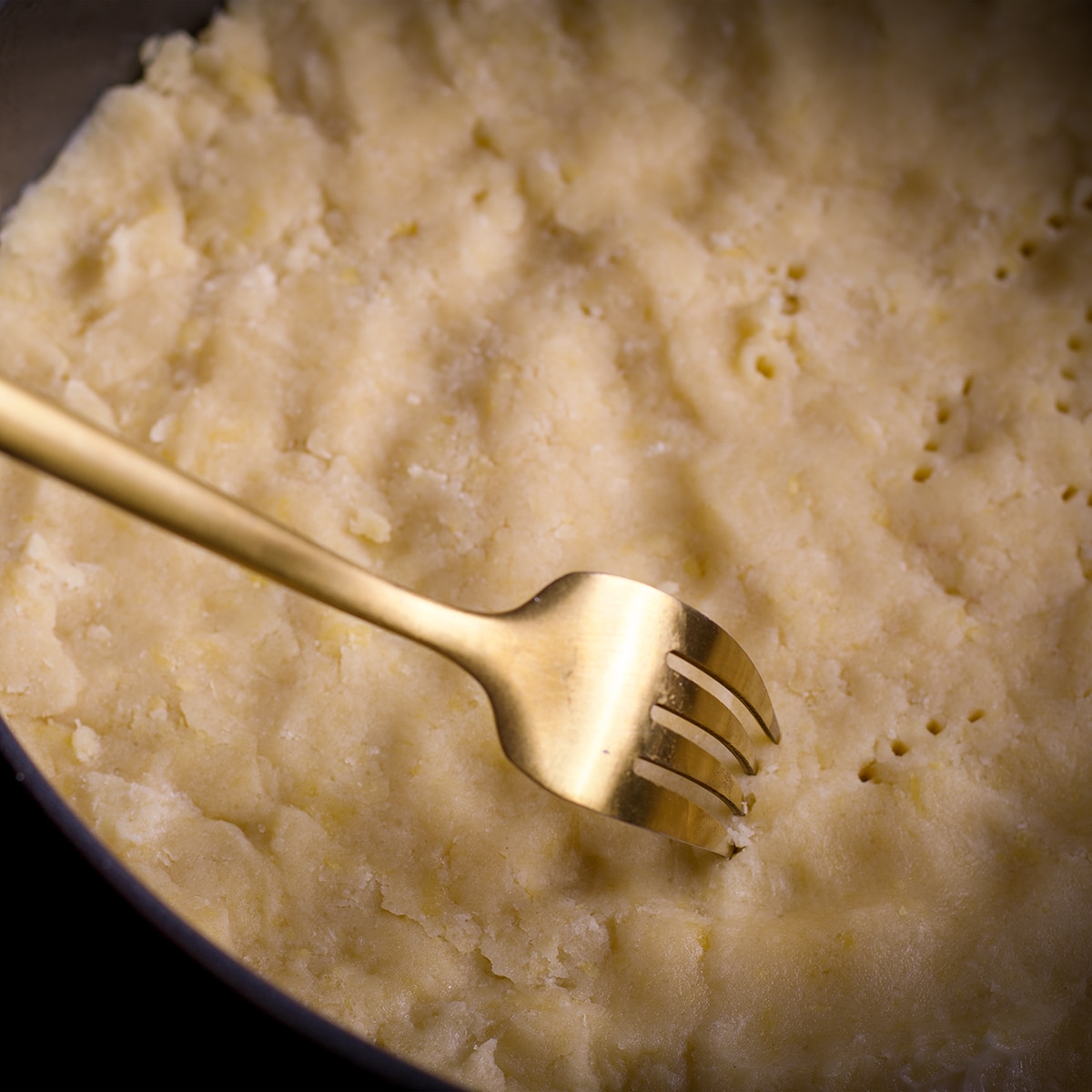
Prick the dough all over with a fork and then bake for about 15 minutes
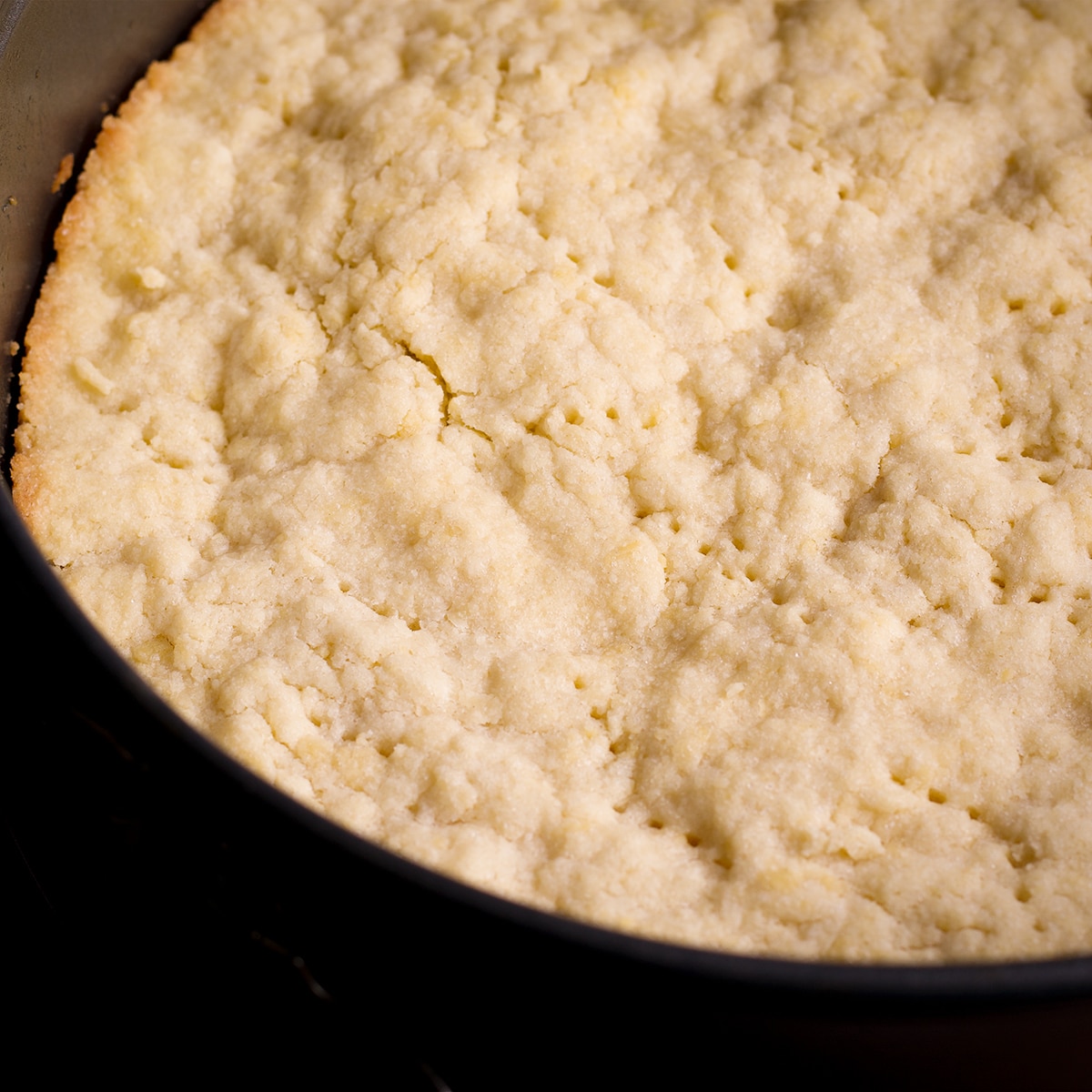
Let the crust cool while you make the cheesecake batter.
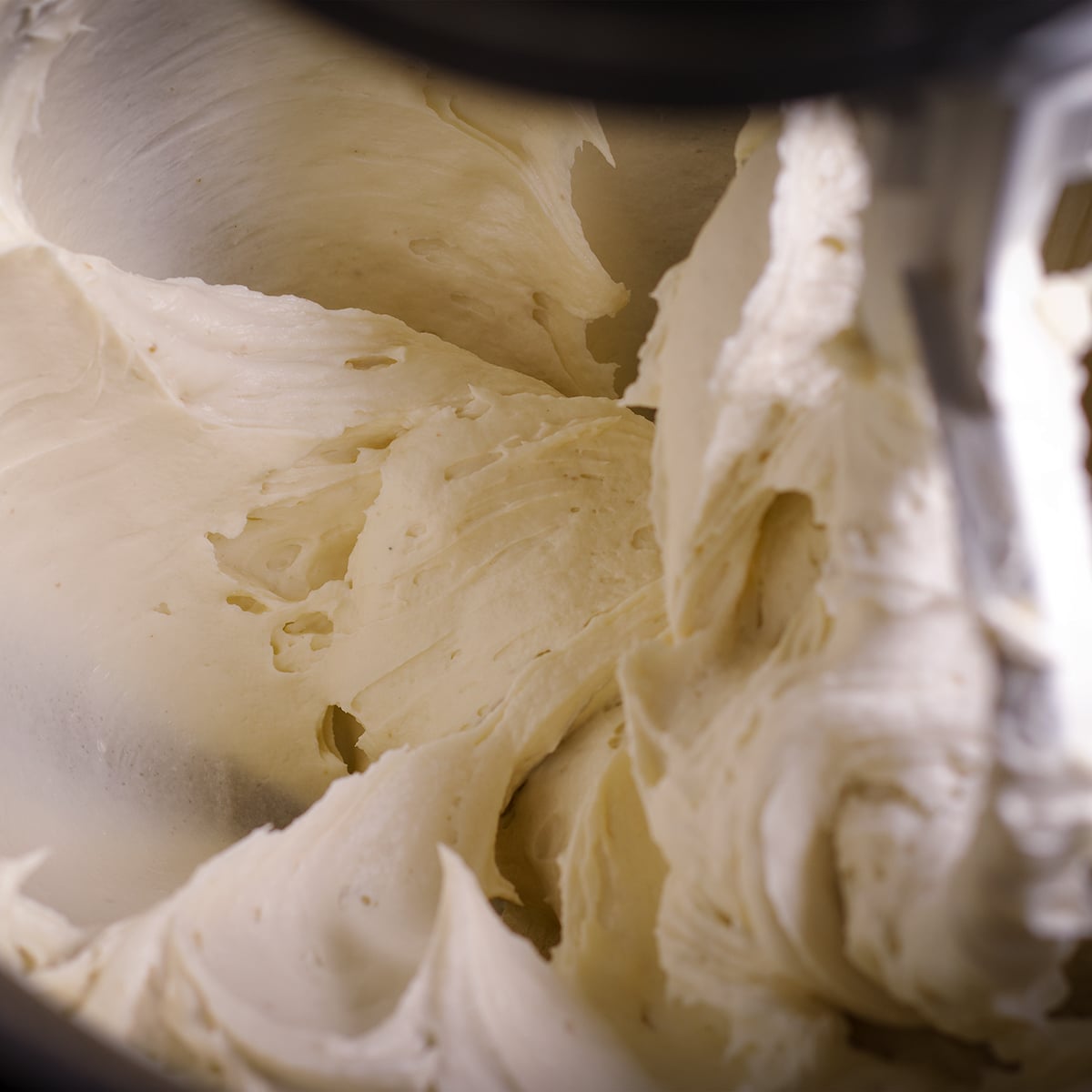
Use an electric mixer to beat the cream cheese, sugar, flour, and salt until creamy and completely smooth.
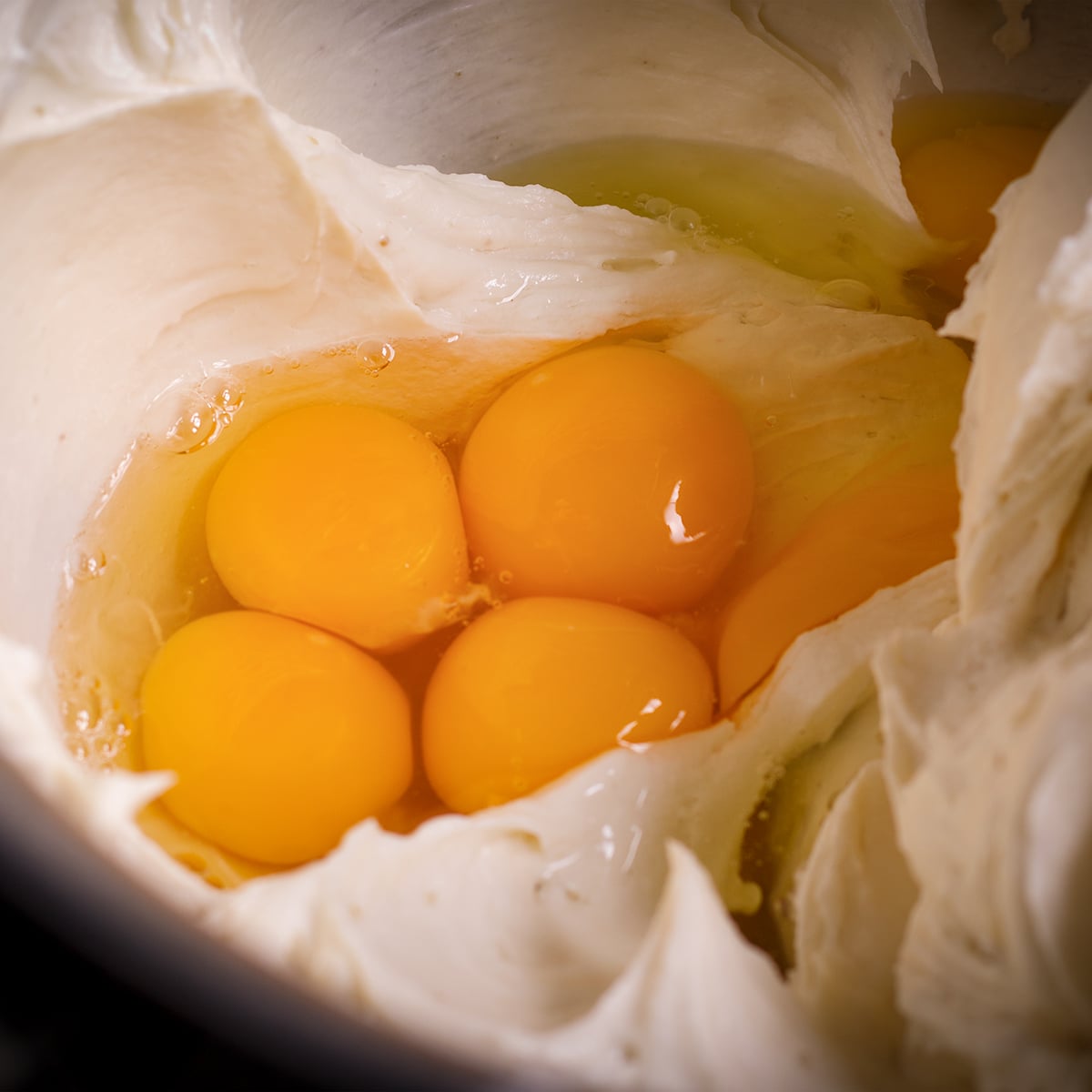
Add the whole eggs and the egg yolks and beat until they are incorporated into the batter.
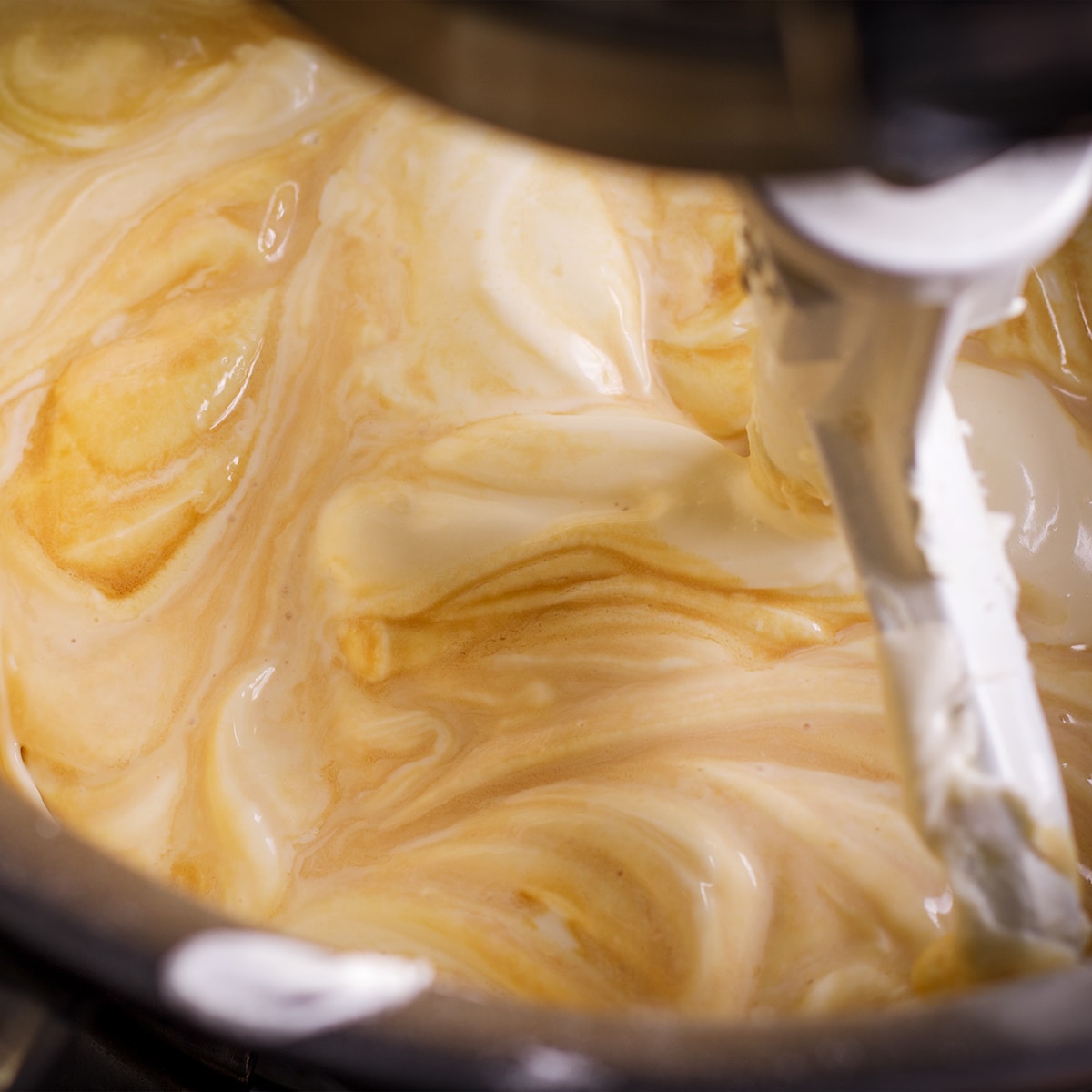
Add the cream and vanilla and mix just until incorporated.
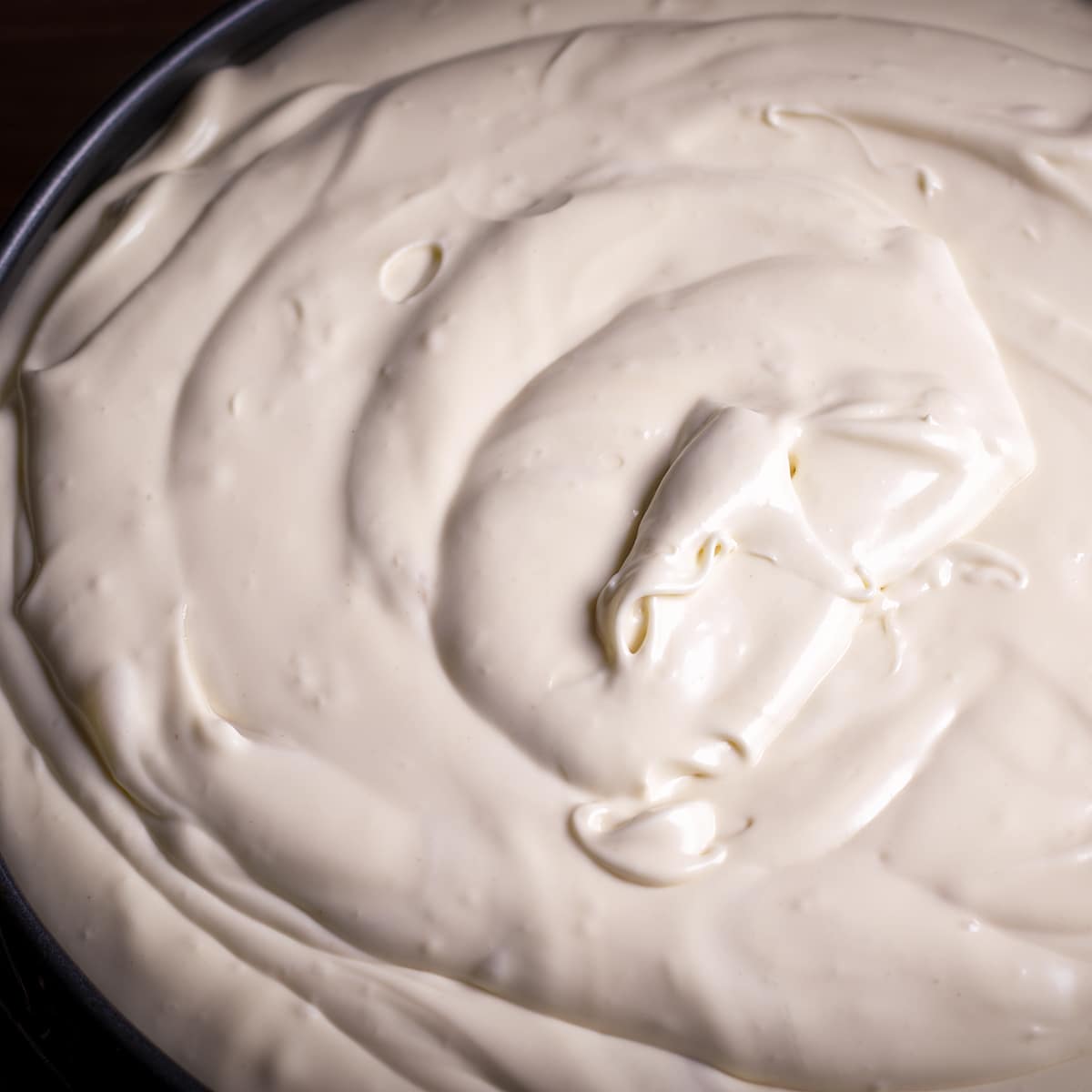
Pour the cheesecake batter into the crust. The batter will come up nearly to the top of the pan.
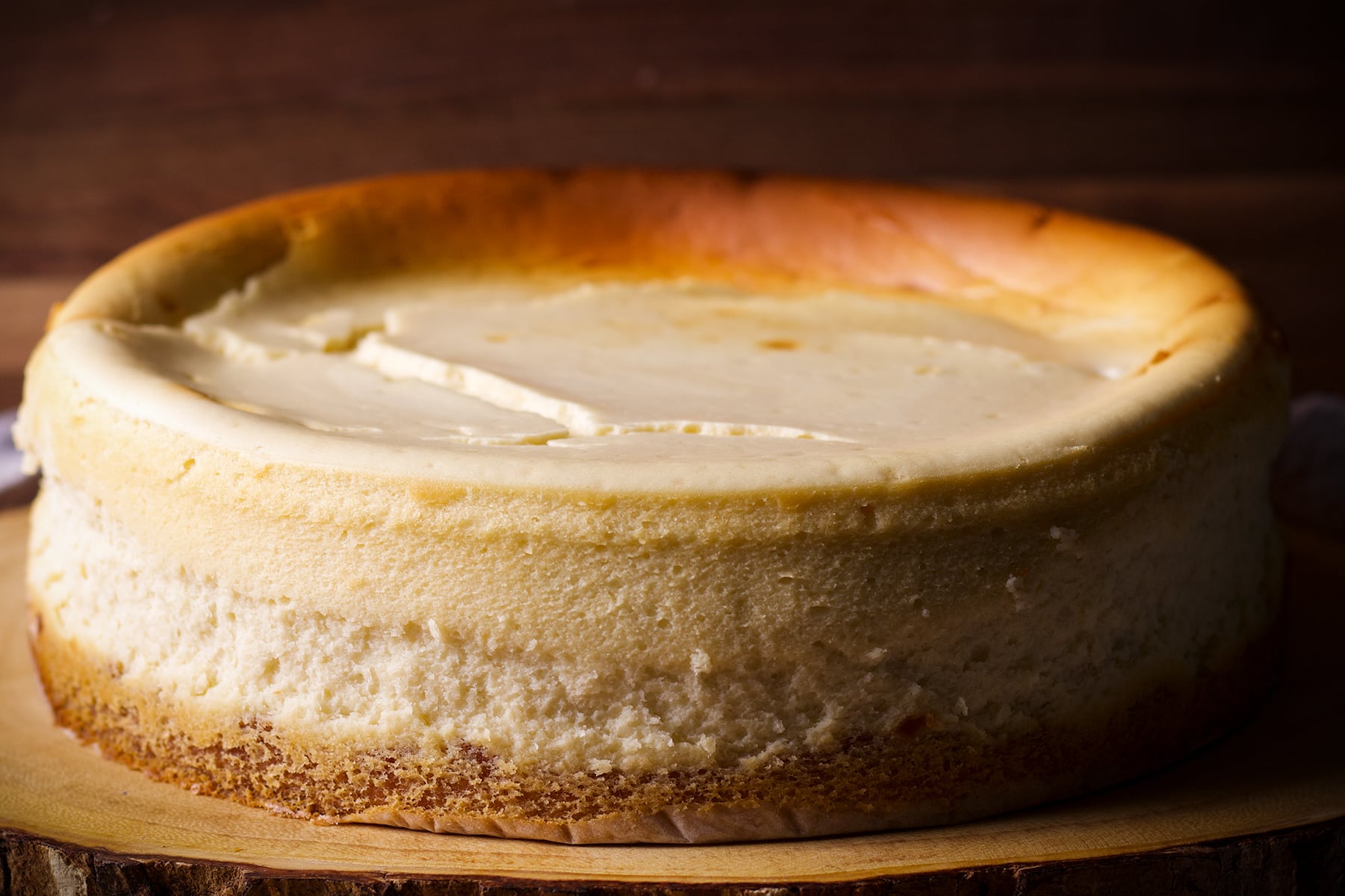
Bake the cheesecake at 475 degrees F (246 degrees C) for 15 minutes.
Leaving the oven door closed, reduce the oven temperature to 200 degrees F (93 degrees C) and bake for 50-60 minutes longer.
How to know when the cheesecake is done: Very gently shake the pan. You should see a small amount of movement, a slight wobble, in the center of the cheesecake, but it will be clearly set. If the center appears liquidy when you gently shake the pan, it needs longer to bake. Be patient. Cheesecake cannot be rushed.
Turn off the oven and leave the cheesecake in the oven with the door closed for 30 minutes.
Remove the cheesecake from the oven and let it cool completely on a wire rack. Pop it in the refrigerator, uncovered, for about 2 hours, until it's chilled. Then, cover the cheesecake and continue refrigerating for a total time of at least 8 hours.
Pro tip: When baking Cheesecake, patience is a virtue.
New York Cheesecake is incredibly thick and requires long, slow baking and 8 - 10 hours to cool and set. When cooked for a long time at high temperatures, the proteins in eggs get tough and become tightly coiled.
But, when cooked gently, at a low temperature, they create a texture that's rich and silky-smooth. As in most things, when it comes to cheesecake, patience is a virtue.
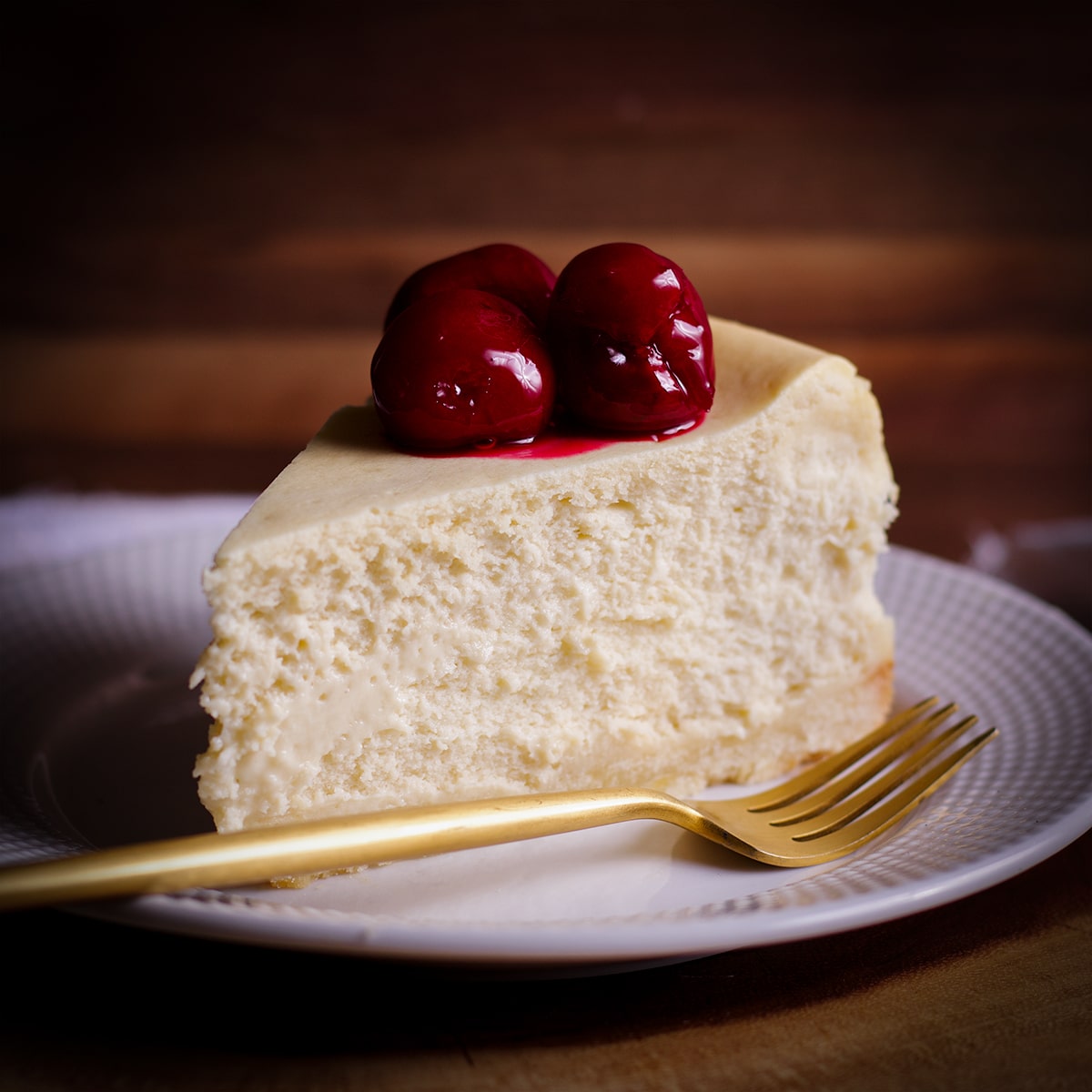
Do You Have to Bake Cheesecake in a Water Bath?
Nope.
This cheesecake is not baked in a water bath. Instead, it’s baked at a high temperature for 15 minutes, then at a very low temperature to ensure it stays creamy inside.
Baking the cheesecake at a high temperature for a few minutes creates a steam-induced "spring" in the cheesecake batter that keeps the consistency from being overly heavy.
When you bake cheesecake at a low temperature for the entire time, usually in a water bath, it creates an ultra dense texture that can feel heavy. This method avoids that.
Here's the downside: your cheesecake might crack. The steam from baking cheesecake in a water bath helps it rise nice and slowly, reducing the risk of cracks on the surface of the cake.
I care MUCH more about texture and flavor than cracks in the surface. I've used this cheesecake recipe hundreds of times for every kind of occasion - even for wedding cakes. Sometimes it cracks, sometimes it doesn't.
As you can see in the photo above, the cheesecake I baked for these photos has a crack in the top. Do I care? Not even a little bit. Did I rush to bake another one just so it would look perfect for the photos? Nope.
I'll choose taste and texture above aesthetics every single time. No contest.
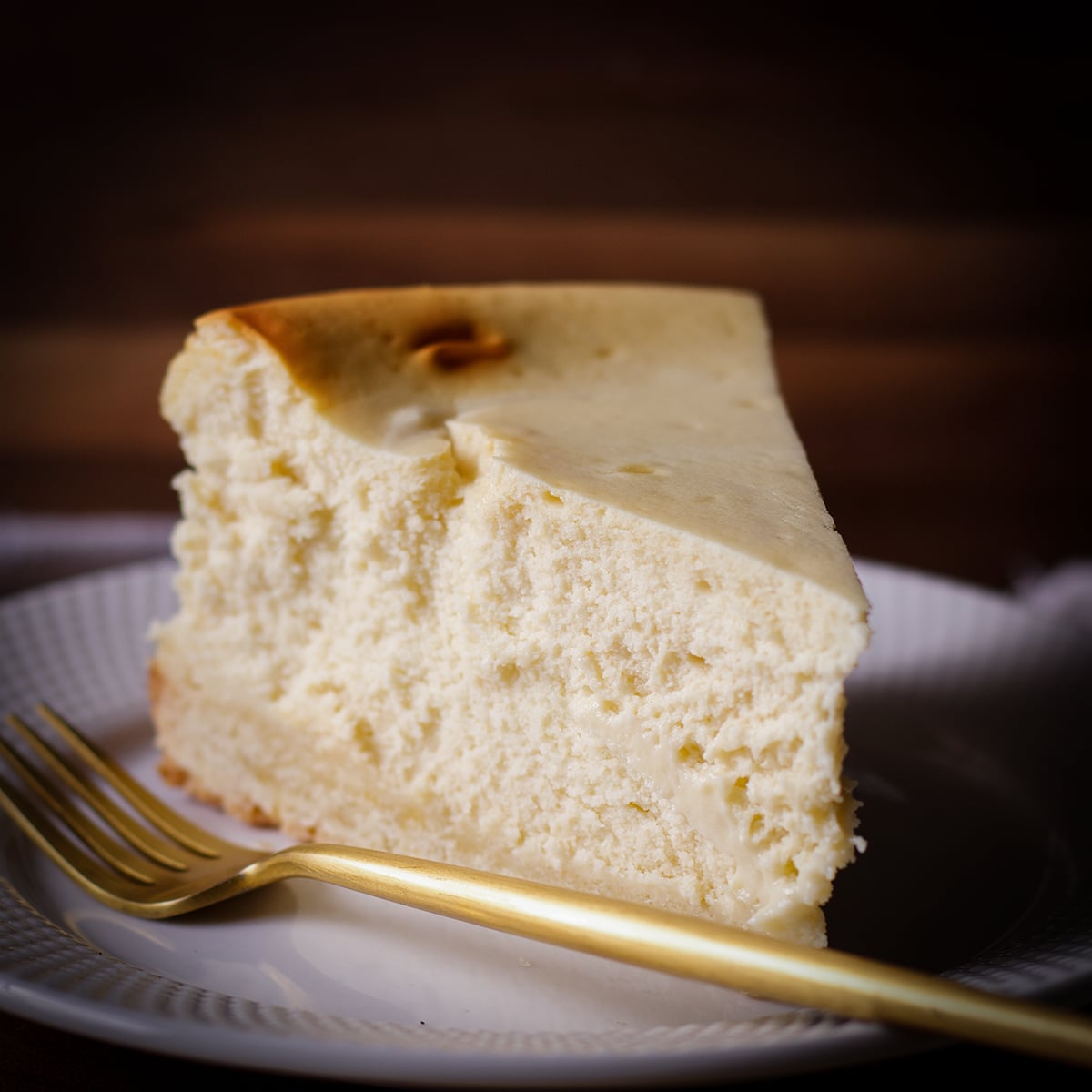
How to Bake a Cheesecake Wedding Cake
You can bake this cheesecake in any size cake pan, but be sure to use deep pans with 3-inch sides. Remove the cheesecake from the pan by setting it in a larger pan that's been filled with hot water. Run a knife around the outside of the pan to release the sides of the cake.
Then, set a large baking sheet that's been covered in parchment paper over the top of the cake and flip the whole thing over onto the baking sheet. Quickly, set another baking sheet that's also been covered in parchment paper over the cake and flip it again so it's right side up.
Tips for Baking Cheesecake in a Standard Cake Pan (not a springform pan):
- Be sure the cake is well chilled (at least 8 hours in the refrigerator) before trying to turn it out. If you want added assurance, pop it in the freezer for a couple of hours.
- This is a tall cake, but it's not as tall as a traditional layer cake. If you're wanting to create the appearance of tall, decorated layers, set the cheesecake on top of a styrofoam cake dummy and then decorate the entire thing. That's what I did in the photo below - each of the 6 cheesecakes sit atop a styrofoam round to create the appearance of tall layers.
- Every wedding I ever made this for was in the middle of summer. To deal with the heat, I decorated the layers with Italian Meringue Buttercream, then put them in individual boxes and set them in the freezer at least a week before the event. I removed them from the freezer right before transport, setting them up at the venue and adding finishing touches. When it was time to serve, the cakes were thawed, but still perfectly cool.

Storage and Freezing Instructions
- This cheesecake will keep well in the refrigerator, covered, for up to 4 days.
- Or, freeze this cheesecake for up to 3 months.
Some recipes claim that you can't freeze cheesecake that doesn't include sour cream. This is simply not true. This cheesecake, which contains heavy cream instead of sour cream, freezes beautifully for up to 3 months.
The most important thing to remember when freezing cheesecake is to wrap it well. I usually wrap it in 2 layers of plastic wrap and then a layer or two of aluminum foil.
To freeze the whole cheesecake: Leave the cake in the pan or remove it to a flat plate or cake board. Allow the cheesecake to thaw, still wrapped, in the refrigerator overnight.
To freeze slices of cheesecake: Separate slices with pieces of parchment paper, then push the slices together, wrap them up, and pop them in the freezer. The parchment paper separators will allow you to remove as few or as many slices as you like.
Cheesecake Topping Ideas
My favorite thing to serve with New York Cheesecake is Cherry Sauce.
Cherry sauce is one of those things I make all summer long, spooning it over ice cream, cakes, pancakes, waffles, scones, biscuits and cheesecake. But, you can also use frozen cherries to make it any time of year.
Other great cheesecake topping options include:
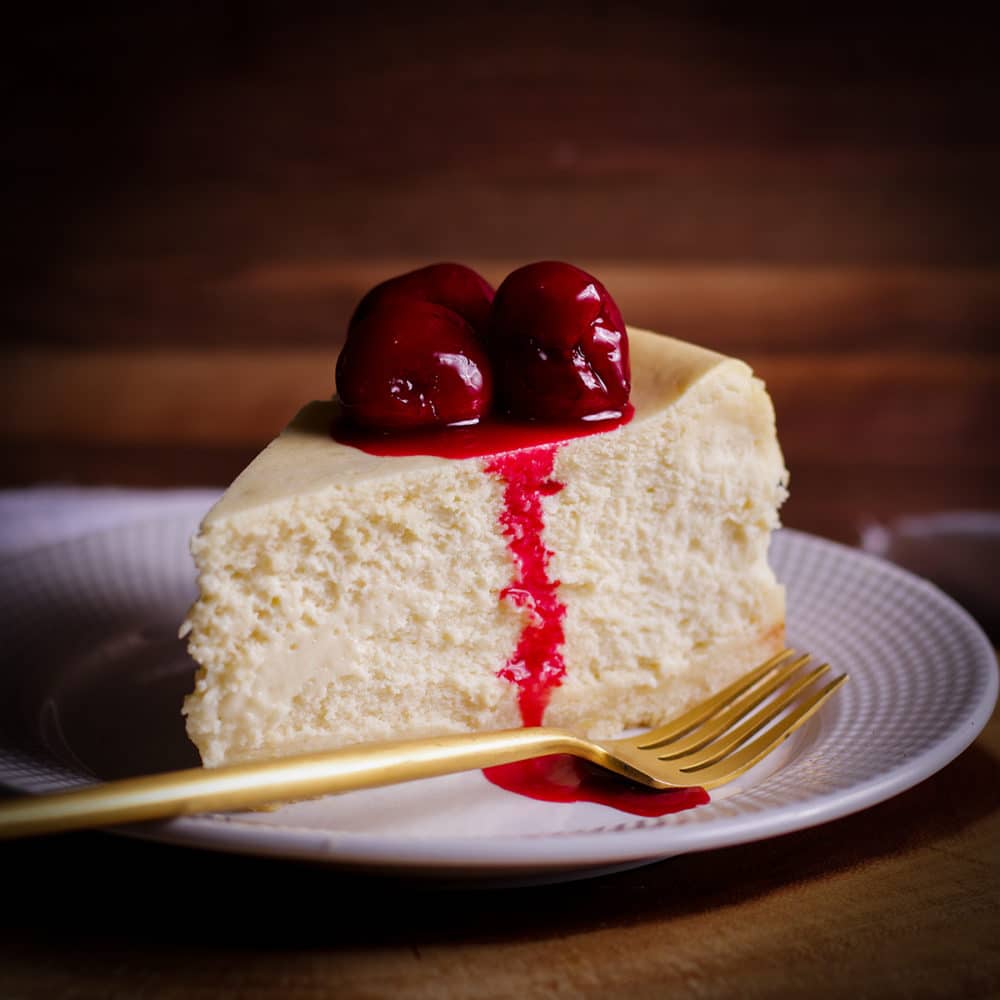
FAQs
The easiest pan to bake a cheesecake in is a springform pan. Springform pans have a removable bottom and sides. The side is flexible and can be tightened or released with a latch.
Springform pans eliminate the need to turn a cake out of the pan. Instead, you simply release the latch and remove the sides of the pan from the cake. Easy, peasy.
Since the consistency of a cheesecake is delicate and creamy, turning it upside down to remove it from a pan is tricky to say the least. With a springform pan, you don't have to.
Having said that, I have baked this cheesecake in regular cake pans of all sizes - up to a 16 inch round cake pan. I did this for a couple of weddings in which I was tasked to make cheesecake for around 350 people. It's tricky, but it can work. (Scroll up for tips on baking cheesecake in a standard cake pan)
Yes! I've included the ingredient amounts for a 10-inch springform pan in the notes section of the recipe card below.
There is no need to make any other adjustments to the recipe, but you might need to let the cake bake for a bit longer. Just keep an eye on the cake at the end of baking, letting it bake for as long as it needs to. The cake is done when the center is set, but still has a little bit of wobble when you gently shake the pan.
Follow the instructions for the graham cracker crust, substituting crushed cookies for the crushed graham crackers. Just be sure to use cookies that are nice and crisp, like Oreos or Biscoff cookies. Soft cookies will not work well for this cheesecake.
Yes. Room temperature ingredients blend together better, plain and simple. If you try to beat cold cream cheese with cold eggs, they won't come together and create a smooth, cohesive batter.
The easiest way to bring ingredients to room temperature is to simply remove them from the refrigerator a couple of hours before you plan to start baking. But, if you are anything like me, you'll rarely remember to do this. So, here's how to bring dairy to room temperature quickly.
New York Cheesecake is a Building Block Recipe
Building block recipes are tried-and-true recipes that I consider foundational to great home baking. They are the kind of recipes I come back to over and over again, sometimes baking them as is, but often using them as a jumping off point to create something new. > Scroll through all Building Block recipes.

+ Subscribe to my newsletter for new and exclusive recipes in your in-box every month! As a full time traveler, living, working, cooking, and baking from a 5th wheel RV, it's also where I share our experiences of life on the road.
📖 Recipe
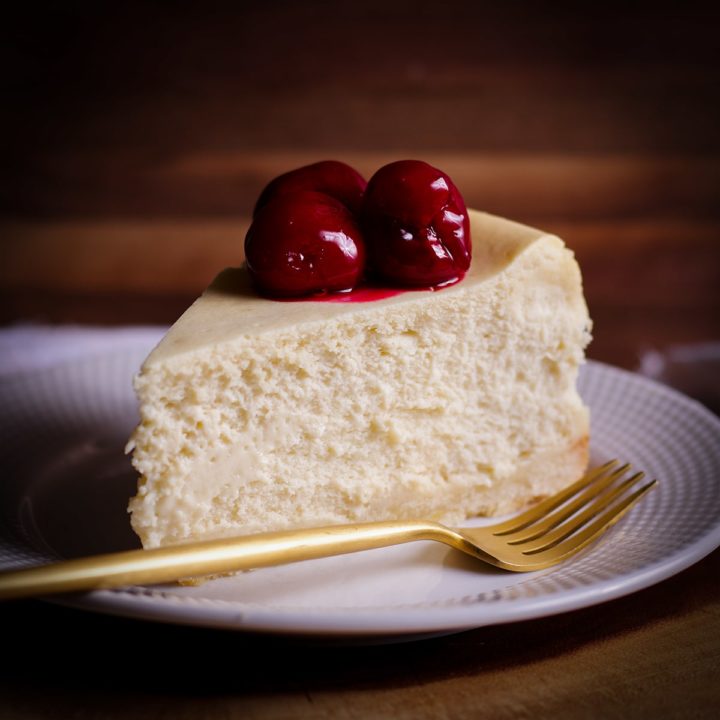
New York Cheesecake with a Shortbread Crust
This is everything you need to know to bake the ultimate rich and creamy New York-style cheesecake. The recipe includes a traditional shortbread crust, but if a graham cracker crust is more your style, scroll down to the notes section of this recipe for instructions.
Ingredients
For the Shortbread Crust:
- 1 ½ cups (180 grams) flour
- ⅓ cup (66 grams) sugar
- 1 large egg
- ½ cup (4 ounces/ 113 grams) butter, at room temperature *I use salted, but use unsalted if you're sensitive to salt
For the Cheesecake Batter:
- Four 8-ounce packages (32 ounces/ 908 grams total) of cream cheese, full-fat, at room temperature
- 1 ½ cups (297 grams) granulated sugar
- ¼ cup (30 grams) all-purpose flour
- 1 teaspoon (6 grams) table salt
- 4 large eggs, at room temperature
- 2 large egg yolks, at room temperature
- ¼ cup (2 ounces/ 56 grams) heavy whipping cream
- 1 tablespoon pure vanilla extract
Instructions
- Preheat the oven to 400 degrees F (204 degrees C). Prepare a 9-inch springform pan as follows: Spray the inside of the pan lightly with non-stick baking spray. Cut out a parchment round to fit the bottom of the pan and press it into the pan. Spray the parchment lightly with non-stick baking spray.
- Add all the shortbread crust ingredients to a bowl and stir until all the flour is moistened with butter and a dough forms. Dump the dough into the prepared pan and press it into an even layer with your fingers so that it covers the bottom of the pan and comes about ½-inch up the sides.
- Prick the dough all over with a fork approximately 20 times. Bake the crust for 15 minutes. Remove the pan from the oven and let it cool while you make the batter.
- Heat oven to 475 degrees F (246 degrees C).
- Beat the cream cheese, sugar, flour, and salt with an electric mixer on medium-high speed until creamy and completely smooth, about 2 minutes. Scrape down the sides of the bowl.
- Add the eggs and egg yolks and beat on medium-high speed until well combined, about 2 minutes more.
- Add the heavy cream and vanilla extract and mix on low just until combined.
- Pour the cheesecake batter into the crust. The batter will come up nearly to the top of the pan.
- Set the pan on a baking sheet and place it in the oven. Bake for 15 minutes. Leaving the oven door closed, reduce the oven temperature to 200 degrees F (93 degrees C) and bake for 50-60 minutes longer. To know when the cheesecake is done: Very gently shake the pan. You should see a small amount of movement, a slight wobble, in the center of the cheesecake, but it will be clearly set. If the center appears liquidy when you gently shake the pan, it needs longer to bake. Be patient. Cheesecake cannot be rushed.
- Turn off the oven and leave the cheesecake in the oven with the door closed for 30 minutes.
- Remove the cheesecake from the oven and let it cool completely on a wire rack. Refrigerate uncovered for about 2 hours, until chilled. Then, cover the cheesecake and continue refrigerating for a total time of at least 8 hours, or overnight.
Make the Shortbread Crust:
Make the Cheesecake:
Notes
If you'd rather use a 10-inch springform pan, make these adjustments to the amounts of the ingredients
- Shortbread crust - no change.
- Five 8-ounce packages cream cheese (40oz/ 1135g total)
- 1 ¾ cups (346g) granulated sugar
- ¼ cup (30g) all-purpose flour
- 5 large eggs
- 2 large egg yolks
- ¼ cup (60ml/ 56g) heavy whipping cream
- 3 teaspoon vanilla extract
How to make a graham cracker crust instead of the shortbread crust:
- Preheat the oven to 375 degrees. Prepare a springform pan as directed in the recipe - fit the bottom with a round of parchment paper and spray the parchment and sides of the pan with a bit of non-stick baking spray.
- Dump 1 ½ cups (140g) of crushed graham crackers, 5 tablespoon (70g/ ⅖oz) melted butter, 2 tablespoon (25g) granulated sugar, and ½ teaspoon salt into a bowl. Stir until all the crumbs are moistened, then press them into an even layer on the bottom of the pan. (If the mixture seems dry, add a bit more melted butter.)
- Bake the crust for 10 minutes, then remove the pan from the oven and set aside to cool.
How to store this cheesecake:
This cheesecake will keep well in the refrigerator, covered, for up to 4 days. You can also freeze it for up to 3 months. To freeze, wrap the cheesecake in 2 layers of plastic wrap then another layer or two of aluminum foil.
If you're freezing the cheesecake whole, you can leave it in the pan, or remove it to a flat plate or cake board. Allow the cheesecake to thaw, still wrapped, in the refrigerator overnight.
You can also freeze this cheesecake in slices. Separate slices with pieces of parchment paper, then push the slices together, wrap them up, and pop them in the freezer. The parchment paper separators will allow you to remove as many slices as you like.
What to serve with New York Style Cheesecake:
Recommended Products
As an Amazon Associate and member of other affiliate programs, I earn from qualifying purchases.
Nutrition Information:
Yield: 12 Serving Size: 1 sliceAmount Per Serving: Calories: 583Total Fat: 39gSaturated Fat: 22gTrans Fat: 0gUnsaturated Fat: 13gCholesterol: 226mgSodium: 536mgCarbohydrates: 49gFiber: 0gSugar: 34gProtein: 11g


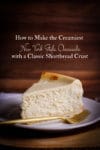
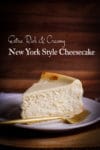
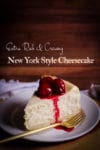
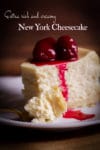

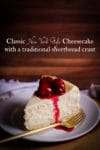



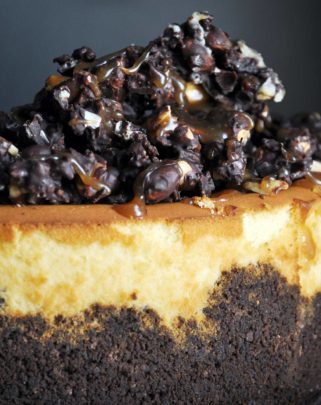
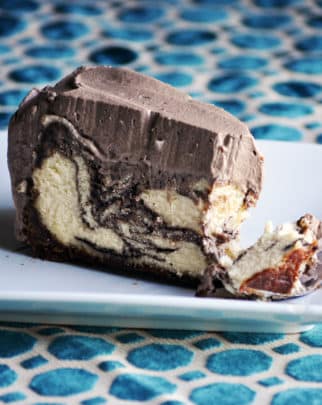
Jackie says
A M A Z I N G!
I grew up in New York and always loved a good NY style cheesecake (plain with a shortbread crust). I’ve only attempted making cheesecake a couple times without great results, but this is the absolute perfect recipe! Even my brother who has been making cheesecakes for several years says he will be switching to this recipe! Thank you!!!
Rebecca Blackwell says
Hi Jackie! I am so happy to hear that this recipe worked out so well for you! It's been my favorite recipe for many years and I absolutely love knowing that it's the new favorite for your family as well. Thanks so much for taking the time to leave a comment for me. I truly appreciate it!
Ann says
The cheese cake top burnt after 10 minutes … unfortunately, I will probably have to cut it out. I will try again & immediately cover with foil . I have a Miele oven , 5 years old .
Rebecca Blackwell says
Hi Ann! What a bummer. I really don't have any idea why the cake burned so quickly... I would love to offer some suggestions for why this might have happened but it just doesn't make any sense to me. It almost sounds like the broiler element was turned on... do you think that's a possibility? Regardless, I know how frustrating it is to have something you've put time and effort into not turn out as you'd hoped and am so sorry to hear that your cheesecake burned. xo
Claudia says
Will definitely be trying this recipe. I am using the bottom of a double oven which is smaller than an average oven. I’m wondering if putting the pan on a baking sheet would not have the heat distribute correctly in a smaller oven. Can you bake without the baking sheet?
Rebecca Blackwell says
Hi Claudia! Great question. My oven is actually 4 inches smaller than a standard-size oven and I keep a pizza steel on the rack at all times because it seems to help heat distribution and helps protect the bottom of whatever I'm baking from being too close to the heating element. So, I actually think that baking the cheesecake on a baking sheet in a smaller oven will work to your advantage. Does that help? Please let me know if you have any other questions! And I'd love to hear how your cheesecake comes out!
Amanda says
Hello - I’m excited to try this cheesecake recipe! Curious, is there any way to make it in an 8x11 dish or does that alter the outcome too much? Thank you!
Rebecca Blackwell says
Hi Amanda! I've never tested this recipe in an 8x11 pan, but I don't see any reason why it wouldn't work. I would grease and flour the inside of the pan well to ensure that it doesn't stick. This recipe should make the right amount of cheesecake batter for that size pan, so no adjustments are needed there. But, I'm honestly unsure about the bake time... Follow the instructions to bake it at 475ª for 15 minutes then reduce the oven temperature to 200ª. Because the cheesecake won't be as thick if you bake it in an 8x13 pan instead of a 9-inch springform pan, my guess is that it won't take quite as long to bake. Just pay attention to it. If it's looking done, very gently shake the pan. You should see a small amount of movement, a slight wobble, in the center of the cheesecake, but it will be clearly set. I hope that helps! Please let me know if you have any other questions! And, I'd love to hear how this works out for you! xo
Elena says
Hi Rebecca,
This looks delicious and I appreciate your detailed process instructions.
Do can you reduce this recipe for an 8" pan? It's 80% the size of a 9" pan, but I'm not sure how to reduce the eggs.
Thanks!
Rebecca Blackwell says
Hi there! You could reduce the eggs by using 3 whole eggs and 2 yolks. Then if you reduce all the other ingredients to 80%, I think you'll be good. The other option is to just make a full batch, fill your pan 90% full and just discard any remaining batter. I know some people hate the idea of wasting any batter, but there will probably not be much "extra". I hope that helps! Please let me know if you have any other questions! And, I'd love to hear what you think of this cheesecake after you make it! xo
Jenny says
Really easy to make and delicious result! Great cheesecake
Rebecca Blackwell says
I'm so happy to hear that Jenny! Thank you so much for taking the time to leave a comment for me! And thank you for participating in the Bake Club! xo
Vineeta Vogel says
Loved this recipe and it tastes delicious! I was really nervous as I have never made a cheesecake before. The instructions were great. The only thing that didn't work right is that the top of my cheesecake for really brown...is there anything I can do to stop that?
Rebecca Blackwell says
Hi Vineeta! I'm so happy to hear that your first cheesecake was a success! My guess is that the super brown top has something to do with the heat distribution in your oven. Every oven is different. Yours most likely, for whatever reason, just reflects a lot of heat from the top. 🙂
If you want to avoid that next time, simply lay a piece of aluminum foil over the top of the cheesecake when you notice that the top is getting too brown. Or, lay the foil over the top of the cheesecake at the start of baking, while baking it for the first 15 minutes at high heat, then remove the foil from the cake to let it finish baking. You might want to spray the foil with a bit of non-stick baking spray just to ensure that it won't stick to the top of the cake. But, that should keep the cake from getting overly brown.
I hope that helps! Please let me know if you ever have any other questions! And thank you for participating in the Bake Club! xo
SHARYN says
The cheesecake looks just wonderful. Since I am a lazy cook and looking for the short cut always could I use a store-bought package of shortbread cookies for a crust?
Rebecca Blackwell says
Hi Sharyn! Yes! You could use store-bought shortbread cookies for the crust. In the notes section of the recipe card, you'll see instructions for making a graham cracker crust. Just follow those same instructions, substituting in crushed shortbread cookies instead of graham crackers. Having said that, I'm not sure you'll be saving yourself much in the way of time. The crust for this cheesecake takes about 5 minutes to make. It might actually take slightly longer to crush shortbread cookies and mix them up into a crust. 🙂
Either way, please let me know if you have any other questions! And, I would love to know what you think of this cheesecake after you make it! xo
Judy says
This is hands down the perfect cheesecake. Great texture, flavor, not overly sweet, something I always get requests for. I’ve made the fudge version without the fudge, but I’m so glad the plain version is now published. Another winner!!
Rebecca Blackwell says
I'm so happy that you're getting so much use out of this recipe Judy! Thank you so much for taking the time to leave a comment for me. I appreciate it so much! xo
Mela Sarda says
First time making this style cheesecake. Searched for recipes online and settled on yours. Flour crust, flour in filling and the use of whipping cream were some of the standouts for me as I read your recipe. I like a little cake like texture. Not greasy. So off I went collecting ingredients and following your instructions I thought to a T. Well… a few things I need to improve on. 1. Baked on the upper shelf and my top crust got eventually too dark. Is middle shelf better? 2. My shortbread crust was too hard to cut through and too dark. Impossible to cut with cake slice. What did I do wrong? 3. My batter became a bit too salty. I used Himalayan pink salt. Is that the issue? 4. Beautiful rise but sunk down too much. No cracks though. Any suggestions? I really want to make this again as the flavor and texture is what I wanted but these few things spoiled it somewhat. Thanks for reading and any hints.
Rebecca Blackwell says
Hi Mela! Thanks so much for reaching out with your questions! 1. Yes, baking on the middle shelf is better for this cake and most cakes. In general, it's best to bake in the center of your oven. Having said that, every oven is different; most ovens are not super accurate when it comes to temperature and might not conduct heat evenly. So, even though you have the best chance of getting an even bake by baking in the center of your oven, that doesn't mean things won't sometimes bake unevenly. For this cake, covering the top of the cake with a sheet of aluminum foil will keep the top from getting too brown. Next time, start baking the cake uncovered, then if it starts to get too brown, lay a piece of foil over the top of the cake - don't press it into the cake, just lay it on top.
2. Because your shortbread crust was over-baked and the cake sunk quite a bit, I'm wondering if your oven temperature might be off? It's very common for ovens to not be accurate. You can get an inexpensive oven thermometer at most supermarkets or on Amazon to test your oven temp. It's also possible that the air isn't circulating inside your oven and "settling" under the pan causing the bottom of the cake to over-bake. A little experimenting should help to find what works for you. Next time, try not baking the crust before topping it with cheesecake batter. Just press the crust into the pan, top it with cheesecake batter, and bake. The crust will still bake through and should be much more tender. If you find it's slightly too soft, try baking it for just 5-7 minutes before topping it with cheesecake batter.
3. I think you've identified the cause of the batter being too salty. Different kinds of salt can vary widely in how salty they make food especially depending on how finely it's ground. For example, a tablespoon of table salt weighs 18 grams and a tablespoon of Kosher salt weighs 8 grams. I realize from your question that including the weight of salt in this recipe might be helpful, so I've added that. I hope that helps! The other thing that might be happening with Himalayan salt is that it's not melting into the batter evenly. Try table salt next time and see if that makes a difference.
4. New York Cheesecake should sink down in the center slightly... since yours sunk more than that but didn't crack, my guess is that baking the cake in the center of the oven and testing to make sure your oven temperature is accurate should correct this issue.
I hope that helps! Please let me know if you have other questions and I'd really love to know if you have better luck with this cheesecake next time! Keep me posted. 🙂
Mela says
Thank you kindly for all your answers. Great suggestions! I will let you know how the next one turns out. I’m determined to become an expert cheesecake baker!